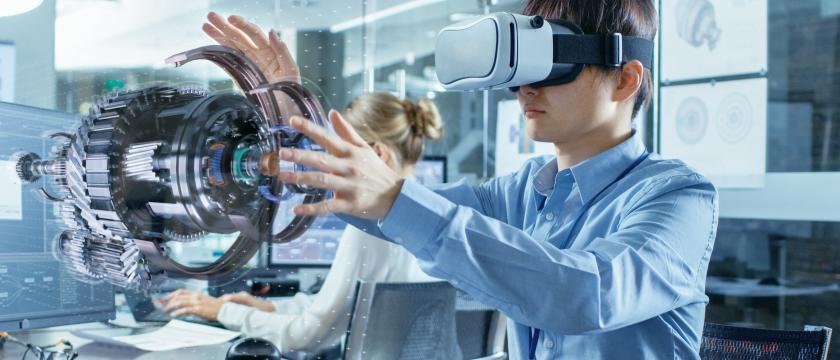Virtual Reality in Engineering – Are You Ready?

Using Virtual Reality to Gain a Competitive Edge
In today’s fast-changing world, speed to market is a crucial differentiator for successful products. However, while process efficiency gives you an edge, it is not always the solution. Design iteration and change invariably impact production, which causes rippling effects throughout the lifecycle, leading to significant delays and rework. As the digital transformation trend picks up across many industries, companies are starting to reap the benefits of early design validation through digital twins. Has your company embraced virtual reality in engineering? Have you wondered what technologies truly impact your product, your employees and ultimately allow you to influence your customers positively?

Virtual Reality in Engineering Design
A lot has transpired in virtual reality since the early days of science fiction movies featuring it. Today’s VR technology is affordable, readily available, and incredibly capable of enabling things at a fraction of the cost of yesteryears. Furthermore, through advancements in software, hardware, and gaming, VR headsets create a near-perfect reproduction of the real world, which holds a lot of potential in the engineering and design worlds.
One major use case for virtual reality in engineering is to allow your designers to experience the product design virtually at full scale, even before a physical prototype is cut. Engineers can call up the bill of materials, load the Computer-Aided Design data, and immerse themselves in VR to experience the product design. This enables them to assess the look and feel of the finished product and gain critical insights into how the product may be built and serviced.
For an example, see the adjacent video that shows how a user can perform a serviceability assessment of a part in a tightly packaged engine chamber inside a truck. The electrical starter component placed in this truck requires frequent servicing in the field. The design engineer needs to assess the placement of this component such that a person can successfully remove and replace it without damaging the equipment. Using Teamcenter BOM, the engineer can configure the truck with all its parts in their correct positions, fire up the Teamcenter Visualization viewer, and see the CAD data in 3D. Viewing the CAD model on the desktop already adds value but switching to VR to immerse a full-scale environment changes the game altogether.
In VR, the user can virtually stand next to the truck, adjust his viewpoint according to his height and use his virtual hands to reach for and grab the starter. This gives him access to reachability information that is simply unavailable on a desktop. Using a few simple gestures and menu interactions, the user can easily attach the part to a virtual controller, physically held in his hand. Once attached, he has the full 6 degrees of freedom to wiggle and move the part around to extract it out of its space intuitively. While he does this, the system continually provides feedback when collisions occur (visual, haptic, etc.) for real-time guidance. At the same time, the system can also calculate a collision-free path in real-time to make it available for further path analysis. In this way, while the system does the complicated math to figure collision-free routes, the engineer gets to intuitively experience what a service engineer might have to deal with in repairing the part in the field. Having this kind of intangible information early on in the design phase can eliminate serious engineering problems that tend to trigger changes down the line.
Seamless VR for Engineers
Teamcenter Visualization VR takes users into an immersive 3D environment using their JT models. Using familiar Teamcenter Visualization navigation features from within the immersive environment, users can view and analyze the 3D model properly, enabling human factors and ergonomic analyses impossible in a 2D environment. In addition, VR increases the clarity of traditional digital mockup operations like interference and clearance measurements, sectioning, positioning, and markup.
The software provides a seamless, single-click transition to VR and allows the user to leverage all the feature functions of the product as available on the desktop. Your data is always live in Teamcenter and requires no additional preparation to be viewed in the VR environment. The software supports popular VR headsets such as HTC Vive, Oculus Rift, and Windows Mixed Reality devices and is compatible with most VR-enabled graphics workstations.
At Siemens, our vision is that virtual and augmented reality technologies will eventually enable the digital twin to replace all physical prototypes. It allows realistic interaction with the comprehensive digital twin at any scale, in any environment. Furthermore, these virtual interactions provide product insights that are more comprehensive, faster, lower cost, and more accurate than results obtained by using physical prototypes.
For additional information on Teamcenter Visualization VR – please follow:


